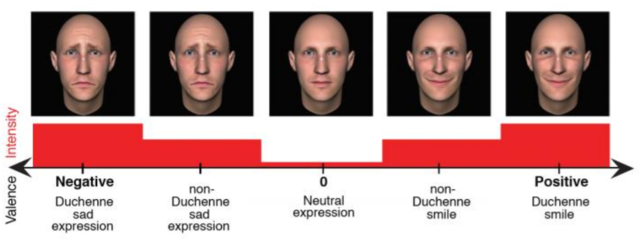Cognition
The Universal Language of Facial Expressions
Duchenne markers around the eye area make people seem more sincere and intense.
Posted June 12, 2018

Photographers and songwriters have long known that the wrinkles around someone’s eyes are a universal way to convey emotional intensity and gritty authenticity. In the iconic 1936 photo of Florence Owens Thompson known as “Migrant Mother,” Dorothea Lange conveyed the hardship and suffering of the Great Depression in a single frame that exemplifies what psychological scientists call the “Duchenne marker” of eye wrinkles.
Duchenne wrinkles are caused by facial muscles in the eye region (orbicularis oculi) that are involved in multiple facial expressions including both “laugh-lines” associated with exuberance and joy or creases near the eyes that convey sadness and pain.
Bruce Springsteen intuitively taps into the timeless and universal power of the “Duchenne marker” in his song, “Racing in the Street,” when he describes the heartbreak of watching his high school sweetheart grow older and bitter. In the most poignant part of this song, Springsteen sings, “But now there's wrinkles 'round my baby's eyes. And she cries herself to sleep at night. When I come home, the house is dark. She sighs, "Baby, did you make it all right?" She sits on the porch of her daddy's house, but all her pretty dreams are torn. She stares off alone into the night, with the eyes of one who hates for just being born.”
"Your wrinkles either show that you're nasty, cranky and senile or that you're always smiling." —Carlos Santana
In the early-20th century, Italian physician and educator, Maria Montessori, realized the importance of studying facial wrinkles. She said, “The study of expression ought to form a part of the study of psychology, but it also comes within the province of anthropology because the habitual, life-long expressions of the face determine the wrinkles of old age, which are distinctly an anthropological characteristic.”
A new study of facial expressions uses 21st-century technology to update Montessori’s observations from a century ago. Using a state-of-the-art technique called “binocular rivalry,” researchers have found that the human brain is pre-wired to view wrinkles around the eyes as the key to conveying sincere and intense emotions of both happiness and sorrow.
This research was conducted by an international team that included the University of Miami Psychology Professor Daniel Messinger, principal investigator Julio Martinez-Trujillo of Western University's Cognitive Neurophysiology Laboratory, along with first author Nour Malek of McGill University, and other collaborators. Their paper, “Generalizing Duchenne to Sad Expressions with Binocular Rivalry and Perception Ratings,” is currently in press and will be published in the journal Emotion.

In a statement, Malek said, "These findings provide evidence of a potential universal language for reading emotions. In other words, a given facial action may have a single role across multiple facial expressions—especially if that facial action shapes your social interactions. For example, knowing if a stranger's smile is genuine and whether that person can be trusted, warns you whether you should evade or not."
The researchers describe their visual rivalry technique as "a window into the unconscious." During binocular visual rivalry, study participants are shown different images in the left and right eye. As the brain struggles to process two slightly different images, it automatically chooses one image to be the primary focus of perceptual awareness. This automatic decision-making process subliminally unearths what someone's brain involuntarily perceives as being the more relevant or important image.

For this study on facial expressions and eye wrinkles, the researchers used computer-generated avatars (seen above) either with or without Duchenne marker wrinkles around the eye area.
As a participant was looking at a Duchenne expression in one eye and a non-Duchenne expression in the other eye, the investigators asked him or her to rate the facial expression for emotional intensity and sincerity. Notably, they found that the majority of participants ranked both Duchenne smiles and Duchenne sad expressions as conveying more intensity and sincerity than non-Duchenne facial expressions that lacked eye wrinkles.
"The expressions involving the Duchenne marker were always dominant. So if the emotion is more intense, your brain actually prefers to bring it into perceptual awareness for longer time," Martinez-Trujillo said in a statement.
"Since Darwin, scientists have wondered if there is a language of facial expression, a key set of what we call facial actions which have simple, basic meanings. This research suggests one key to this language is constriction of the eyes, which appears to intensify both positive and negative expressions," Messinger said in a statement. "This is the first study addressing this issue in adults since Darwin's provocative observations."
In future studies, the researchers plan to use this visual rivalry method to see if the difficulty people with autism spectrum disorder (ASD) often have reading others' emotions might be tied to interpreting the Duchenne marker for sincerity in someone's facial expressions.
References
Malek, N; Messinger, D; Gao, AYL; Krumhuber, E; Mattson, W; Joober, R; Tabbane, K; (2018) "Generalizing Duchenne to Sad Expressions with Binocular Rivalry and Perception Ratings." Emotion (In press)
Nour Malek, Andy Yuan Lee Gao, Daniel Messinger, Eva Krumhuber, Ridha Joober, Karim Tabbane, and Julio Martinez-Trujillo. "Face Inversion Disrupts Holistic Processing of Duchenne Emotions During Binocular Rivalry." Journal of Vision (2016) DOI: 10.1167/16.12.158




